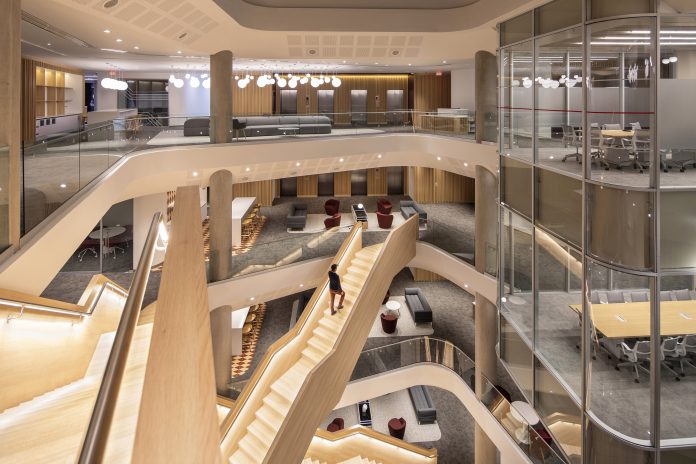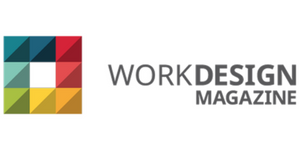- As a force for change, design is as much about practicality and structure as it is emotional and intellectual.
- Where we work needs to support the moods of human beings and the modes of work. The design can not be homogenous, or static.
- Human-centric environments that represent, reflect and empower people with a sense of place can and will create cultural optimism.
This article was written by Executive Vice President and CEO of the International Interior Design Association (IIDA) Cheryl Durst for Work Design Magazine.
I’m often asked to shed light on what’s ‘new’ and ‘next’ in design. While I don’t have a crystal ball, I do have the next best thing: a think tank composed of thousands of design thought leaders across 58 countries.
As an organization, the International Interior Design Association (IIDA) is zeroing in on the future of experience — a topic I very much look forward to digging into at NeoCon this month.
Creating places for the future, and shaping the future of place, means honing our vision until it is crisp and clear, inspired and ambitious.
We have already started to think differently about the places we inhabit, and to expect more from them. Where work environments are concerned, we’re framing these conversations strategically: How can a workplace function as an extension of home for employees while also hosting conferences, sparking collaboration, supporting cultural events, and welcoming the surrounding community? How can these spaces create a sense of belonging while enhancing productivity and well-being?
Now and again, we all need a friendly reminder that design is an incredible force for optimism. It’s about encouraging and amplifying all that we are as human beings. As a force for change, design is as much about practicality and structure as it is emotional and intellectual. Design is also about justice — it’s about putting everyone on seamless, equal footing and creating a supportive environment for social evolution. After all, design is empathetic — it is uniquely concerned with humanity.
IIDA believes that human-centric environments that represent, reflect and empower people with a sense of place can and will create cultural optimism. In my mind’s eye, the future ‘office’ will be anywhere and everywhere — one’s home, a coffee shop or the airport, even atop a picnic blanket in a park. It’s a co-created instance that’s anthropocentric by design. It’s where we choose to place ourselves, our productivity, and the work we are doing. Comfort will play a key role. And these spaces will be accessible to all, and provide a lot of choice on how we do the work we need to do.
That said, offices will remain a high-touch hub for collaboration with an emphasis on wellness and safety. Here, beauty will continue to be incredibly important. Our offices may be sleek, modern and technologically flawless, yet they will still be aesthetically beautiful because that’s what human beings are drawn to.
The future office will incorporate all of the senses and be both calming and energizing, as well as sensitive to neuro-diversity and various aptitudes. Where we work needs to support the moods of human beings and the modes of work. The design can not be homogenous, or static.
What the Future Holds for Architects & Designers
Of course, reexamining the future of place naturally leads us to reexamine the future of practice: How will design firms work in the years and decades ahead? What will it mean to be part of a multi-disciplinary practice or an ecosystem of manufacturers? What new disciplines will be defined by new ways of practicing?
On a more micro-level for the workplace, I foresee resilient design helping to minimize uncertainty by making certain design practices the norm, i.e. creative storytelling to celebrate cultural identities, thoughtful space planning and color psychology to raise hopefulness, and the implementation of niche wellness specializations like lighting, sound and even humidity that are synced to our preference and individual physical needs.

New Tech Now
Embracing emerging tech is an important subtopic as the industry navigates how AI and a burgeoning category of other tech tools can enhance creativity.
During IIDA’s annual design think tank in January, Industry Roundtable, and again in May with Collective Design Season Five, we tackled both the directions advanced technology will take us, the future we can reliably predict for the design profession, and the most important tech for designers to know now.
It’s an important, ongoing conversation, and one that IIDA will continue to explore with our members and the larger design ecosystem. I’m excited about where these tools can take us, and I’m reminded again that the intrinsic capabilities of designers — our high aptitude for empathy and centering the built environment on human needs — are exactly what a technology-shaped future needs.

Want More?
By staying curious about new technologies, methodologies, and community engagement, we can make the future of placemaking less about the fear of the unknown and more about the excitement of what’s to come. At the 2024 NeoCon conference (June 10 – 12 at The Mart in Chicago), IIDA will be sharing knowledge and expertise, as well as a vision of where we are headed next as an industry, through the lens of human experience and design’s innate connection to and impact on humanity.
From the contagious enthusiasm of our youngest cohort of designers to the leaders and visionaries of the moment, we are creating the future of design in real time — and we invite you to be a part of the journey.
The International Interior Design Association (IIDA) hosts events during NeoCon at the Merchandise Mart in Chicago, IL on Monday June 12, 2023. Photographer: Christopher Dilts / IIDA


 Dr. Gleb Tsipursky – The Office Whisperer
Dr. Gleb Tsipursky – The Office Whisperer Nirit Cohen – WorkFutures
Nirit Cohen – WorkFutures Angela Howard – Culture Expert
Angela Howard – Culture Expert Drew Jones – Design & Innovation
Drew Jones – Design & Innovation Jonathan Price – CRE & Flex Expert
Jonathan Price – CRE & Flex Expert













